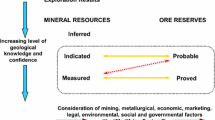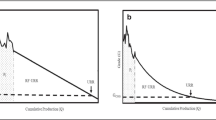Abstract
Comprehensive anthrobiogeochemical metal cycles that incorporate material flow through the natural, social, and interfacing system have been constructed to illustrate the interacting geomorphic forces of human activity. As the purveyor of what is arguably the Anthropocene epoch, human society has a responsibility to manage the movement of these metals in a way that preserves their sustained availability while minimizing the potential impacts on the natural environment. Global metal cycles constructed for aluminum (Al), iron (Fe), copper (Cu), zinc (Zn), silver, nickel, lead, and chromium quantify how humans at the beginning of the twenty-first century have come to cause approximately half the metal mass mobilization on Earth. For the industrial metals of Al, Fe, Cu, and Zn, ∼1–5% of the Earth’s land surface now has metal flow dominated by people. These traditionally mined metals are accumulating as in-use stock in highly concentrated bands in the developed world, a secondary resource available for recovery through recycling. The pattern of ore depletion and translocation to in-use stock accumulation highlights an implicit metal material wealth transfer from the developing to developed world, having long-term implications for understanding which parts of the world actually hold the wealth of “natural” metal resources. Further, this research highlights the human–nature interfaces of metal mass flows that should be the target of environmental management.



Similar content being viewed by others
Notes
References
Andreae MO, Merlet P (2001) Emission of trace gases and aerosols from biomass burning. Global Biogeochem Cycles 15:955–966
Carey AE, Nezat CA, Lyons WB, Kao SJ, Hicks DM, Owen JS (2002) Trace metal fluxes to the ocean: the importance of high-standing oceanic islands. Geophys Res Lett 29:14–11
Carr ME, Friedrichs MAM, Schmeltz M, Noguchi Aita M, Antoine D, Arrigo KR, Asanuma I, Aumont O, Barber R, Behrenfeld M, Bidigare R, Buitenhuis ET, Campbell J, Ciotti A, Dierssen H, Dowell M, Dunne J, Esaias W, Gentili B, Gregg W, Groom S, Hoepffner N, Ishizaka J, Kameda T, Le Quéré C, Lohrenz S, Marra J, Mélin F, Moore K, Morel A, Reddy TE, Ryan J, Scardi M, Smyth T, Turpie K, Tilstone G, Waters K, Yamanaka Y (2006) A comparison of global estimates of marine primary production from ocean color. Deep-Sea Res II Top Stud Oceanogr 53:741–770
Dentener F, Kinne S, Bond T, Boucher O, Cofala J, Generoso S, Ginoux P, Gong S, Hoelzemann JJ, Ito A, Marelli L, Penner JE, Putaud JP, Textor C, Schulz M, van der Werf GR, Wilson J (2006) Emissions of primary aerosol and precursor gases in the years 2000 and 1750 prescribed data-sets for AeroCom. Atmos Chem Phys 6:4321–4344
Drakonakis K, Rostkowski K, Rauch J, Graedel TE, Gordon RB (2007) Metal capital sustaining a North American city: iron and copper in New Haven, CT. Resour Conserv Recycl 49:406–420
Eckelman M, Rauch JN, Gordon RB (2007) In-use stocks of iron in the state of Connecticut. Yale University, New Haven
European Aluminium Association (2004) Aluminium recycling: the road to high quality products. European Aluminium Association, Brussels
Gerst MD, Graedel TE (2008) In-use stocks of metals: status and implications. Environ Sci Technol 42:7038–7045
Gordon RB, Bertram M, Graedel TE (2006) Metal stocks and sustainability. Proc Natl Acad Sci U S A 103:1209–1214
Graedel TE, Van Beers D, Bertram M, Fuse K, Gordon RB, Gritsinin A, Kapur A, Klee RJ, Lifset RJ, Memon L, Rechberger H, Spatari S, Vexler D (2004) Multilevel cycle of anthropogenic copper. Environ Sci Technol 38:1242–1252
Graedel TE, van Beers D, Bertram M, Fuse K, Gordon RB, Gritsinin A, Harper EM, Kapur A, Klee RJ, Lifset R, Memon L, Spatari S (2005) The multilevel cycle of anthropogenic zinc. J Ind Ecol 9:67–90
Hooke RL (2000) On the history of humans as geomorphic agents. Geol 28:843–846
Ito A, Penner JE (2004) Global estimates of biomass burning emissions based on satellite imagery for the year 2000. J Geophys Res-Atmos 109:D14S05
Jain AK, Tao Z, Yang X, Gillespie C (2006) Estimates of global biomass burning emissions for reactive greenhouse gases (CO, NMHCs, and NOx) and CO2. J Geophys Res Solid Earth 111:D06304
Johnson J, Jirikowic J, Bertram M, Van Beers D, Gordon RB, Henderson K, Klee RJ, Lanzano T, Lifset R, Oetjen L, Graedel TE (2005) Contemporary anthropogenic silver cycle: a multilevel analysis. Environ Sci Technol 39(12):4655–4665
Johnson J, Schewel L, Graedel TE (2006) The contemporary anthropogenic chromium cycle. Environ Sci Technol 40:7060–7069
Johnson J, Harper EM, Lifset R, Graedel TE (2007) Dining at the periodic table: metals concentrations as they relate to recycling. Environ Sci Technol 41(5):1759–1765
Kapur, A. (2004) The future of the red metal: scenario analysis and implications for policy. Dissertation, Yale University
Klee RJ, Graedel TE (2004) Elemental cycles: a status report on human or natural dominance. Annu Rev Environ Resour 29:69–107
Mackenzie FT, Lerman A, Andersson AJ (2004) Past and present of sediment and carbon biogeochemical cycling models. Biogeosciences 1:11–32
Mao JS, Dong J, Graedel TE (2008) The multilevel cycle of anthropogenic lead II. Results and discussion. Resour Conserv Recycl 52:1050–1057
Milliman JD, Syvitski JPM (1992) Geomorphic tectonic control of sediment discharge to the ocean: the importance of small mountainous rivers. J Geol 100:525–544
Müller DB, Wang T, Duval B, Graedel TE (2006) Exploring the engine of anthropogenic iron cycles. Proc Natl Acad Sci U S A 103:16111–16116
Nordhaus WD (2006) Geography and macroeconomics: new data and new findings. Proc Natl Acad Sci U S A 103:3510–3517
Nriagu JO (1979) Copper in the environment. Wiley, New York
Nriagu JO (1990) Human influence on the global cycling of trace-metals. Glob Planet Chang 82:113–120
Nriagu JO, Pacyna JM (1988) Quantitative assessment of worldwide contamination of air, water and soils by trace metals. Nat 333:134–139
Olivier JGJ, Aardenne JAV, Dentener FJ, Pagliari V, Ganzeveld LN, Peters JAHW (2005) Recent trends in global greenhouse gas emissions: regional trends 1970–2000 and spatial distribution of key sources in 2000. J Integr Environ Sci 2:81–99
Pacyna JM, Scholtz MT, Li YF (1995) Global budget of trace metal sources. Environ Rev 3:145–159
Poulton SW, Raiswell R (2000) Solid phase associations, oceanic fluxes and the anthropogenic perturbation of transition metals in world river particulates. Mar Chem 72:17–31
R. W. Beck Inc (2001) U.S. Recycling Economic Information Study. National Recycling Coalition, Washington, DC
Rauch JN (2009) Global mapping of Al, Cu, Fe, and Zn in-use stocks and in-ground resources. Proc Natl Acad Sci U S A 106:18920–18925
Rauch JN (2010) Global spatial indexing of the human impact on Al, Cu, Fe, and Zn mobilization. Environ Sci Technol 44:5728–5734
Rauch JN, Graedel TE (2007) Earth’s anthrobiogeochemical copper cycle. Global Biogeochem Cycles 21:GB2010
Rauch JN, Pacyna JM (2009) Earth’s global Ag, Al, Cr, Cu, Fe, Ni, Pb, and Zn cycles. Global Biogeochem Cycles 23:GB2001
Rauch JN, Eckelman M, Gordon RB (2007) Copper in-use stock and copper scrap in the state of Connecticut. Yale University, New Haven
Raw Materials Group (2006) Raw materials data. Raw Materials Group, Solna
Reck B, Müller DB, Rostkowski K, Graedel TE (2008) The anthropogenic nickel cycle: insights into use, trade, and recycling. Environ Sci Technol 42:3394–3400
Richardson GM, Garrett R, Mitchell I, Mah-Paulson M, Hackbarth T (2001) Critical review on natural global and regional emissions of six trace metals to the atmosphere. Risklogic Scientific Services, Ottawa
Rudnick RL, Gao S (2003) Composition of the continental crust. In: Rudnick RL et al (eds) Treatise on geochemistry. Elsevier, Oxford, pp 1–64
Sörme L, Bergbäck B, Lohm U (2001) Century perspective of heavy metal use in urban areas. A case study in Stockholm. Water Air Soil Pollut Focus 1:197–211
Spatari S, Bertram M, Gordon RB, Henderson K, Graedel TE (2005) Twentieth century copper stocks and flows in North America: a dynamic analysis. Ecolog Econ 54:37–51
Sullivan DE (2003) Productive capacity indicator 5.2: indicators of stocks-in-use in the United States for aluminium, copper, gold, iron and steel, lead, and zinc. Geological Survey, Reston
Sutton PC, Costanza R (2002) Global estimates of market and non-market values derived from nighttime satellite imagery, land cover, and ecosystem service valuation. Ecol Econ 41:509–527
Syvitski JPM, Peckham SD, Hilberman R, Mulder T (2003) Predicting the terrestrial flux of sediment to the global ocean: a planetary perspective. Sediment Geol 162:5–24
van Beers D, Graedel TE (2003) The magnitude and spatial distribution of in-use copper stocks in Cape Town, South Africa. S Afr J Sci 99:61–69
van Beers D, Graedel TE (2004) The magnitude and spatial distribution of in-use zinc stocks in Cape Town, South Africa. Afr J Environ Assess Manag 9:18–36
van Beers D, Graedel TE (2007) Spatial characterisation of multi-level in-use copper and zinc stocks in Australia. J Clean Prod 15:849–861
van der Werf GR, Randerson JT, Giglio L, Collatz GJ, Kasibhatla PS, Arellano AF Jr (2006) Interannual variability in global biomass burning emissions from 1997 to 2004. Atmos Chem Phys 6:3423–3441
Wang T, Müller DB, Graedel TE (2007) Forging the anthropogenic iron cycle. Environ Sci Technol 41:5120–5129
Westberry T, Behrenfeld MJ, Siegel DA, Boss E (2008) Carbon-based primary productivity modeling with vertically resolved photoacclimation. Global Biogeochem Cycles 22:GB2024
Wittmer D, Lichtensteiger T, Baccini P (2003) Copper exploration for urban mining. In: Copper 2003. Canadian Institute of Mining, Metallurgy, and Petroleum, Montreal, pp 85–101
Yevich R, Logan JA (2003) An assessment of biofuel use and burning of agricultural waste in the developing world. Global Biogeochem Cycles 17:1095
Zhao M, Heinsch FA, Nemani RR, Running SW (2005) Improvements of the MODIS terrestrial gross and net primary production global data set. Remote Sens Environ 95:164–176
Author information
Authors and Affiliations
Corresponding author
Rights and permissions
About this article
Cite this article
Rauch, J.N. The present understanding of Earth’s global anthrobiogeochemical metal cycles. Miner Econ 25, 7–15 (2012). https://doi.org/10.1007/s13563-011-0011-8
Received:
Accepted:
Published:
Issue Date:
DOI: https://doi.org/10.1007/s13563-011-0011-8




